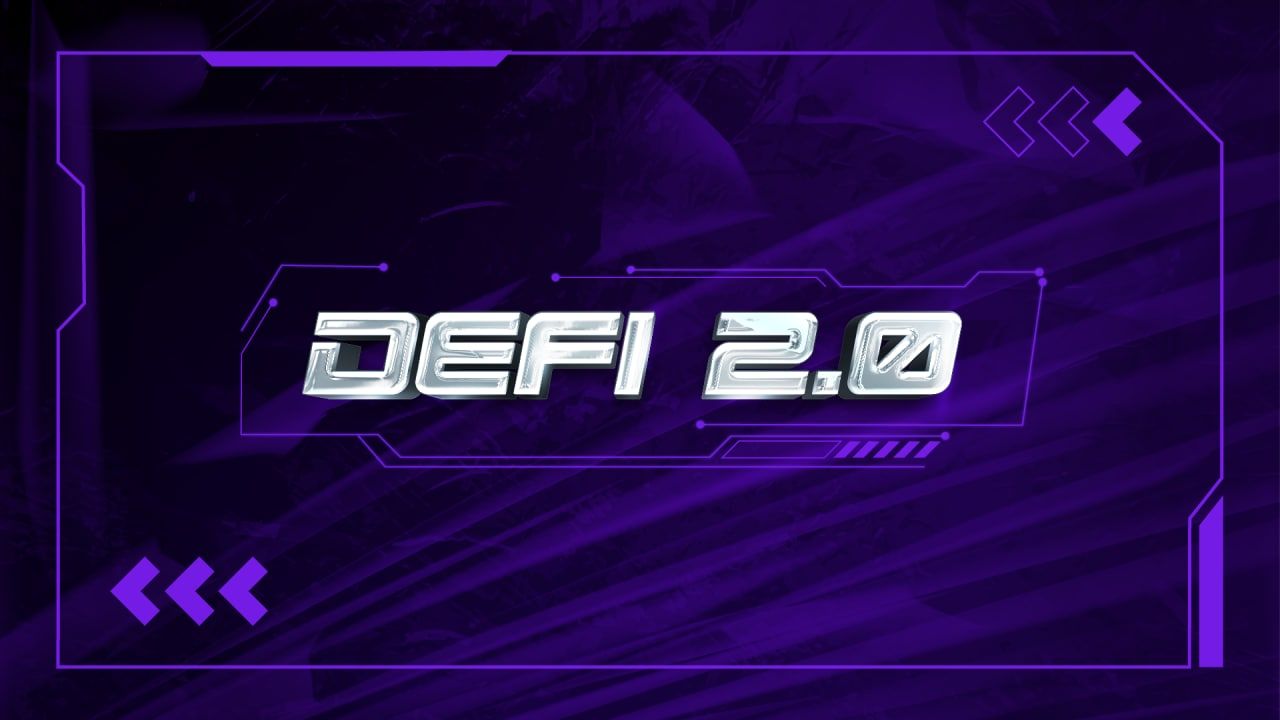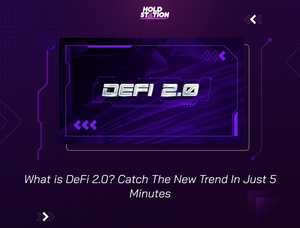Recently, the community involved in investing and interested in crypto must have heard about the DeFi 2.0 keyword at least once. So what is DeFi 2.0? How is it different from the current DeFi 1.0? What is the potential? What to expect? Let's find out with Holdstation through this article!
What is Defi 2.o?

DeFi 1.0 was once a revolution in providing decentralized financial services to anyone with a cryptocurrency wallet, but it still has its weaknesses. Defi 2.0 is, in a word, an upgrade of the limitations and difficulties of the original Defi. A good example of DeFi's success is the Liquidity Pool (LP). It allows liquidity providers to split the trading fee on the liquidity pair provided by the user.
However, if the token's rate changes, liquidity providers will be exposed to the risk of temporary loss. DeFi 2.0 will have a solution to these risks and offer even more benefits for users to encourage people to invest more in LPs in particular and Defi in general.
Limitations of Defi 1.0
First, let's take a look at the limitations of DeFi 1.0 with Holdstation to understand why DeFi 2.0 was born:
- Scalability: Defis on blockchains have high traffic and expensive transaction fees. This has resulted in a slow and expensive user experience and service.
- Third-party oracles and information: Financial products that rely heavily on external data need high-quality oracles.
- Centralization: Becoming more and more decentralized has always been a goal in DeFi. However, many projects have not yet adopted the principles of DAO (Decentralized Autonomy).
- Security: Many users use DeFi but few know and understand its risks. There are investors who have even staked thousands of dollars into smart contracts but don't really know if it's safe or not. While places that are tested for safety and security tend to be not very profitable.
- Liquidity: Markets and LPs are spread across different blockchains and platforms that have segregated liquidity. In most cases, tokens placed in LPs cannot be used anywhere else, creating capital inefficiencies.
Why is Defi 2.0 important?
The purpose of DeFi is to reduce barriers to entry and create new earning opportunities for crypto users and investors. Especially useful for users who are not loaned by traditional banks, Defi will solve this problem. DeFi 2.0 is important because it has the ability to democratize finance without putting lenders at risk. Besides, Defi 2.0 can improve the problems that users and investors have experienced before in DeFi 1.0.
Outstanding use cases of DeFi 2.0
Multi-chain liquidity
DeFi 2.0 will allow multi-chain linking to address DeFi 1.0's illiquidity weakness. Different blockchains can connect to each other through layers of smart contracts and LPs. Users from there can have access to more assets instead of just a single token. The lack of liquidity of on-chain assets can be easily solved through trading between pools on different chains.
Unlock the value of staked funds
If you ever stake a pair of tokens in a liquidity pool, you will get LP tokens back. With DeFi 1.0, you can stake LP in a yield miner to compound your profits. Before DeFi 2.0, this was how the chain extracted value. Millions of dollars are locked in liquidity pools, opening the door for ideas to improve capital efficiency. DeFi 2.0 has taken it a step further, using yield miners' LP tokens as collateral. It can collateralize a crypto loan from a lending protocol or to mint tokens in a process similar to MakerDAO (DAI). Each project has a different detailed mechanism, but the general idea is that LP tokens unlock value for new opportunities while still generating APY.
Smart contract insurance
Performing advanced due diligence on smart contracts is difficult unless you are an experienced developer. Without this knowledge, you can only evaluate part of the project. This creates quite a risk when investing in DeFi projects. With DeFi 2.0, you can purchase DeFi insurance on specific smart contracts. Imagine you are using a tool for profit optimization and you have staked LP tokens in its smart contract. If the smart contract is hacked, all your deposits may be lost. An insurance project can provide a guarantee for your deposit in yield farm for a fee. Note, this will only be for a specific smart contract. Normally, you will not receive payment if the LP contract has not been approved. However, if the yield farm contract has not been approved but is insured, your losses may be covered.
Temporary loss insurance
If you invest in a liquidity pool and start mining, any change in the price ratio of the two tokens you have locked in could result in financial loss. This process is known as transient loss or transient loss, but DeFi 2.0 protocols are discovering new methods to mitigate this risk. For example, imagine adding a token to an LP that you don't need to add in a pair. The protocol will add their native token as the other side of the pair. Then you and also the protocol will receive fees from the swaps.. Over time, the protocol uses their fees to build an insurance fund to insure your deposit against the effects of temporary losses. If there are not enough fees to cover the losses, the protocol can generate new tokens to cover them. If there is an excess of tokens they can be stored for later use, or burned to reduce the supply.
Loans are automatically repaid
Usually, borrowing money often involves liquidation and interest rate risks. But with DeFi 2.0, this is not necessarily the case. For example, imagine you get a $100 loan from a crypto lender. The lender offers you $100 in crypto but asks for $50 as collateral. After you provide your deposit, the lender can use this money to receive interest, and this interest can be used to pay off your loan. Once the lender has made $100 in your crypto plus a premium as a premium, your deposit will be returned. There is no liquidation risk here. If the token as collateral drops in value, it will only take longer for the loan to be paid off.
Who will control DeFi 2.0?
With all the features and use cases as mentioned above, the question is who will control DeFi 2.0? Yes, talking about blockchain means decentralization. DeFi is no exception. One of the first DeFi 1.0 projects, MakerDAO (DAI), set a standard for the movement. It is now increasingly common for the community to decide on project issues. Many platform tokens also act as governance tokens, providing holders with voting rights. It is reasonable to expect that DeFi 2.0 will bring more decentralization in this area. However, the provisions of the law are being tightened more and more.
What are the risks of Defi 2.0 and how to prevent them?
Like DeFi 1.0, DeFi 2.0 projects are also risky. Here are some common and important things you can do to keep yourself safe.
Smart contracts that you interact with may have backdoors, weaknesses, or attacks
Cross-checking and skimming is never enough to ensure the safety of a project. Research as much as possible about the project and understand that the investment always has potential risks is extremely necessary.
Regulations that may affect your investments
Governments and regulators around the world are interested in the DeFi ecosystem. While regulation and legislation can bring security and stability to crypto, some projects may have to change their offerings in the form of new regional government rules.
Temporary hole
Even with IL (temporary loss) insurance, DeFi is still a big risk for anyone looking to get into liquidity mining. The risk can never be completely mitigated. So it's never too late to prepare mentally for the loss.
An example of DeFi 2.0
The famous DeFi products that most crypto users know such as: Curve Finance, Aave, sushi swap, ... are platforms that have contributed a lot to the improvement of technology in DeFi products, but Activities such as liquidity mining have not yet yielded sustainable profits. Addresses the inherent limitations of DeFi 1.0. The Olympus DAO was born and became a classic example of DeFi 2.0.
Holdstation will soon update the detailed analysis of Olympus DAO!
Summary
While there have been many successful projects in the DeFi space, we have not yet found and exploited the full potential of DeFi 2.0. This topic is still complicated for most users and you should not use financial products without having enough knowledge. There is still a lot of work to be done to keep the process simple, especially for new users. There are already new ways to reduce risk and create compelling APY, but we'll also have to wait and see if DeFi 2.0 fully delivers on what it promises.


